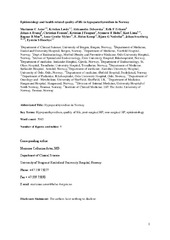Epidemiology and health related quality of life in hypoparathyroidism in Norway
Permanent lenke
https://hdl.handle.net/10037/10438Dato
2016-05-17Type
Journal articleTidsskriftartikkel
Peer reviewed
Forfatter
Astor, Marianne; Løvås, Kristian; Debowska, Aleksandra; Eriksen, Erik Fink; Evang, Johan Arild; Fossum, Jan Christian; Fougner, Kristian J; Holte, Synnøve E.; Lima, Kari; Moe, Ragnar Bekkhus; Myhre, Anne Grethe; Kemp, E. Helen; Nedrebø, Bjørn Gunnar; Svartberg, Johan; Husebye, Eystein SverreSammendrag
Objective: The epidemiology of hypoparathyroidism (HP) is largely unknown. We aimed to determine
prevalence, etiologies, health related quality of life (HRQOL) and treatment pattern of HP.
Methods: Patients with HP and 22q11 deletion syndrome (DiGeorge syndrome) were identified in electronic hospital registries. All identified patients were invited to participate in a survey. Among patients who responded, HRQOL was determined by Short Form 36 and Hospital Anxiety and Depression scale. Autoantibodies were measured and candidate genes (CaSR, AIRE, GATA3, and 22q11-deletion) were sequenced for classification of etiology.
Results: We identified 522 patients (511 alive) and estimated overall prevalence at 102 per million divided among postsurgical HP (64 per million), nonsurgical HP (30 per million), and pseudo-HP (8 per million). Nonsurgical HP comprised autosomal dominant hypocalcemia (21%), autoimmune polyendocrine syndrome type 1 (17%), DiGeorge/22q11 deletion syndrome (15%), idiopathic HP (44%), and others (4%). Among the 283 respondents (median age, 53 years [range, 9 – 89], 75% females), seven formerly classified as idiopathic were reclassified after genetic and immunological analyses, whereas 26 (37% of nonsurgical HP) remained idiopathic.Most were treated with vitamin D (94%) and calcium (70%), and 10 received PTH. HP patients scored significantly worse than the normative population on Short Form 36 and Hospital Anxiety and Depression scale; patients with postsurgical scored worse than those with nonsurgical HP and pseudo-HP, especially on physical health.
Conclusions: We found higher prevalence of nonsurgical HP in Norway than reported elsewhere. Genetic testing and autoimmunity screening of idiopathic HP identified a specific cause in 21%. Further research is necessary to unravel the causes of idiopathic HP and to improve the reduced HRQOL reported by HP patientss. (J Clin Endocrinol Metab 101: 3045–3053, 2016)
Methods: Patients with HP and 22q11 deletion syndrome (DiGeorge syndrome) were identified in electronic hospital registries. All identified patients were invited to participate in a survey. Among patients who responded, HRQOL was determined by Short Form 36 and Hospital Anxiety and Depression scale. Autoantibodies were measured and candidate genes (CaSR, AIRE, GATA3, and 22q11-deletion) were sequenced for classification of etiology.
Results: We identified 522 patients (511 alive) and estimated overall prevalence at 102 per million divided among postsurgical HP (64 per million), nonsurgical HP (30 per million), and pseudo-HP (8 per million). Nonsurgical HP comprised autosomal dominant hypocalcemia (21%), autoimmune polyendocrine syndrome type 1 (17%), DiGeorge/22q11 deletion syndrome (15%), idiopathic HP (44%), and others (4%). Among the 283 respondents (median age, 53 years [range, 9 – 89], 75% females), seven formerly classified as idiopathic were reclassified after genetic and immunological analyses, whereas 26 (37% of nonsurgical HP) remained idiopathic.Most were treated with vitamin D (94%) and calcium (70%), and 10 received PTH. HP patients scored significantly worse than the normative population on Short Form 36 and Hospital Anxiety and Depression scale; patients with postsurgical scored worse than those with nonsurgical HP and pseudo-HP, especially on physical health.
Conclusions: We found higher prevalence of nonsurgical HP in Norway than reported elsewhere. Genetic testing and autoimmunity screening of idiopathic HP identified a specific cause in 21%. Further research is necessary to unravel the causes of idiopathic HP and to improve the reduced HRQOL reported by HP patientss. (J Clin Endocrinol Metab 101: 3045–3053, 2016)
Beskrivelse
Accepted manuscript version. Published version available at http://dx.doi.org/10.1210/jc.2016-1477


 English
English norsk
norsk